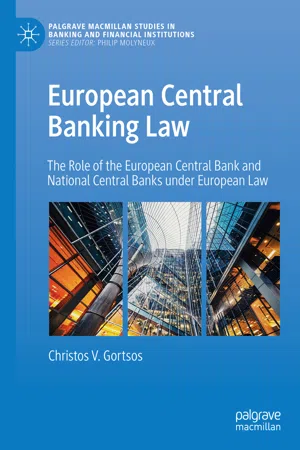1.1.1 The Basic Concepts for the Analysis: Monetary System—Financial System—Payment and Settlement Systems
Introductory Remarks
Central banking law is defined as the law governing the operation and competences of central banks. Central banks are public authorities, with legal personality under national law,1 and play, in almost every jurisdiction, an extremely important role in relation to the functioning of several aspects of the economy and, in particular, to the monetary system and the financial system, including the latter’s infrastructures, that is payment and settlement systems (all briefly presented just below).2 In particular:
(1) In all cases (and traditionally), central banks have the legal monopoly (and quasi de facto monopoly as well) of issuing banknotes and controlling of the amount of coins in circulation produced by the government. They are also assigned the tasks of defining and implementing monetary policy in order to achieve specific, well-defined macroeconomic objectives (related but not identical is the provision of last-resort lending to solvent banks exposed to liquidity risk, which is linked to financial stability), as well as of conducting foreign exchange policy and holding, for that purpose, official foreign reserves (see Sect. 1.1.2). The contribution to financial stability and the smooth operation of payment and settlement systems, including their oversight, also rank among central banks’ traditional functions. In (almost) all cases as well, but mainly after the recent (2007–2009) international (or global) financial crisis,3 powers have been conferred upon central banks in relation to the so-called macro-prudential financial oversight as part of their contribution to financial stability (these aspects are presented in Sects. 1.1.3 and 1.1.4, respectively).
(2) In certain jurisdictions, central banks are also responsible for the authorisation and micro-prudential supervision of banks and, in some cases, of other categories of financial firms (mainly after the recent international financial crisis as well) their resolution (on this, see Sect. 1.1.3). The same applies to (specific) powers relating to the protection of consumers of financial services and the combatting of money laundering and terrorist financing through the banking/financial system (usually, not from a crime prevention perspective, but from a prudential one4). Finally, most recently, several central banks worldwide are responsible for the promotion of financial inclusion and financial literacy (see briefly under Sect. 1.1.5).5
The Monetary System
(1) The monetary system contains the unit of account of a state (with reference to its name and any applicable subdivisions thereof), and comprises, at an institutional level, a central bank (or similar ‘monetary authority’, as it is named for instance in Singapore and Saudi Arabia, or ‘Reserve Bank’ as it is called in the United States and India6), which enjoys the monopoly of issuing national banknotes (on the liability side of a central bank’s balance sheet), controls the quantity of coins issued by the government (i.e. competent Ministry of Finance or corresponding ministry) and provides liquidity to credit institutions operating within its territory.7
(2) According to the ‘State Theory of Money’, a sovereign state is entitled to issue its own money (the money of the state) and create a (national) monetary system. This principle of ‘monetary sovereignty’ has been affirmed in international law. As noted, inter alia, by the Permanent Court of International Justice in the 1929 Serbian and Brazilian Loan Case, “it is indeed a generally accepted principle that a state is entitled to regulate its own currency.”8 In certain cases, small sovereign states have neither their own money nor a domestic monetary system. Even in the European continent, the examples are plenty: Monaco, Andora, San Marino, Liechtenstein or the Vatican State.9 These states enter into bilateral monetary agreements with another state, according to the terms of which the money and the monetary system of the latter apply to the former as well. A distinct case is the formation of a monetary union among (usually, more or less equally sizeable) sovereign states, which decide to transfer their (national) monetary sovereignty to supranational entities issuing a single (or common) currency and operating a supranational, regional monetary system.10
The Financial System
(1) Unlike the monetary system, the content of which is straightforward (at least in terms of design), the financial system is more complicated, since it performs (at least in market economies) two functions through a complex nexus of markets and financial service providers in that system. In particular, the first function is channelling funds from the economy’s positive savers to the negative savers (further discussed just below). The second function consists in enabling natural and legal persons to make payments without using cash, namely coins and banknotes; payment instruments and fund transfer services, through which this function is performed, are principally offered by banks and specialised payment institutions.11
(2) The first above-mentioned function of financial systems is performed via two channels: direct financing of negative savers by positive savers and indirect financing of negative savers by positive savers or financial intermediation.12 The channel of ‘direct financing’ from positive to negative savers is activated through financial markets (also referred to as money and capital markets), where debt instruments and equities are issued and traded and derivatives are traded. Various categories of financial firms operate in direct financing, such as banks, to the extent that they are allowed by law to provide investment se...
